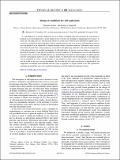Design of conditions for self-replication
Author(s)
Sarkar, Sumantra; England, Jeremy L.
DownloadPhysRevE.100.022414.pdf (1.796Mb)
Terms of use
Metadata
Show full item recordAbstract
A “self-replicator” is usually understood to be an object of definite form that promotes the conversion of materials in its environment into a nearly identical copy of itself. The challenge of engineering novel, micro- or nanoscale self-replicators has attracted keen interest in recent years, both because exponential amplification is an attractive method for generating high yields of specific products and, also, because self-reproducing entities have the potential to be optimized or adapted through rounds of iterative selection. Substantial steps forward have been achieved both in the engineering of particular self-replicating molecules and in the characterization of the physical basis for possible mechanisms of self-replication. At present, however, there is a need for a theoretical treatment of what physical conditions are most conducive to the emergence of novel self-replicating structures from a reservoir of building blocks on a desired time scale. Here we report progress in addressing this need. By analyzing the kinetics of a toy chemical model, we demonstrate that the emergence of self-replication can be controlled by coarse, tunable features of the chemical system, such as the fraction of fast reactions and the width of the rate constant distribution. We also find that the typical mechanism is dominated by the cooperation of multiple interconnected reaction cycles as opposed to a single isolated cycle. The quantitative treatment presented here may prove useful for designing novel self-replicating chemical systems.
Date issued
2019-08-26Department
Massachusetts Institute of Technology. Department of PhysicsPublisher
American Physical Society
Citation
Phys. Rev. E 100, 022414 (2019)
Version: Final published version